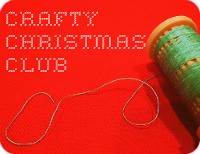Or, at least, she can take the heat, so you won't have to!
She's lined with a super-thick insulating layer on the bottom, and a single layer of cotton batting on the top, with a little bit of stuffing to hold her head up.
By the way - forget the seam allowance on
this one. It took me a minute, looking at the pattern, to decide to chance it with mine, but I was right. The way they've drawn the piece you use for the bottom, it allows for a 1/4" seam in the top pieces. The bit just under the head is a little tricky - you have to make sure you get your binding right up against that seam, or you'll have some raw edges showing. (In fact, I had to take some hand-stitches right up under the neck, just to be sure those raw edges wouldn't escape later - but you can't see them, and I'm satisfied with the effect.)
I made the comb using a scrap of my binding fabric. I cut it 2" x 4", and gathered it up similar to how I did it for the
log cabin chicken. It turned out a little tall, but instead of picking it apart, I stitched it down in two places, dividing it into thirds.
I decided to add a little quilting to the bottom of mine, to help secure the padding in place a bit. I just followed the lines in the print, and made it up as I went. All by machine.
To make it easier to sew the top and bottom together, I zig-zagged my outer edges together, so I'd have the padding and fabric working as one.
I didn't find the color I wanted in commercial bias binding, so I made my own. I cut my fabric 2" wide on the bias, folded down the center and ironed the crease, then folded both edges into the center fold and ironed again. Somewhere in my sewing stuff I've got some of those nifty bias-tape-making do-dads, but I can't seem to find them just now.
I was totally going to machine-stitch the binding on (I even have a special foot for my Singer that will do this, using flat bias - it's awesome!) but with the thickness of this particular bird, I decided to do it like I'd do a quilt binding, sewn on by machine on the top, and hand-stitched down on the underside. For the life of me, I don't know why I didn't do this like I usually do for quilts - fold in half, sew on with raw edges even, and wrap folded edge around to the back - I think it's because I was recently doing some other bias binding, on a pair of pajamas, that had to be done using the double fold stuff. Would have been good to have the double layer of binding on the edge of this. Rats.
There are a couple products on the market that help make a home-made hot pad safe to use.
Insul-Bright has a layer of Mylar,and has the advantage of being very thin, lending itself to greater creative scope, while still providing good heat resistance. I don't like the crinkle sound you get from the Mylar, so I don't use it much.
Another good option is to use multiple layers of
cotton (not poly!) batting. I've had some disappointment with that filler, though, especially if my hot pad gets a little damp.
My personal favorite, which I discovered a couple years back when I used to do the craft fair circuit, is
ironing board padding. Not the flimsy foam variety that often comes with the ironing board, though. This stuff is super-thick, and either needle-punched or quilted together. At first I cut my hot pad filler from used pads, which mom had left underneath the new one on the board. When I ran out of that, I managed to find an online source that offered it in large rectangles, which you'd cut to fit your board. It's been a while now, and my source no longer carries that option, so I'm hoarding the last of it.
I did find you a similar product,
ThermaFlec, which is sold by the yard, and is currently all the rage for casserole carriers and the like.
In any case, I do recommend you use something with heat resistance when you make a hot pad, otherwise burned fingers are bound to happen, and nobody wants that, right?




























